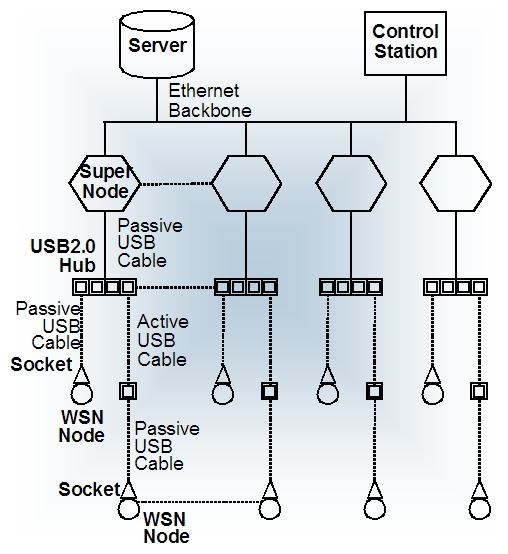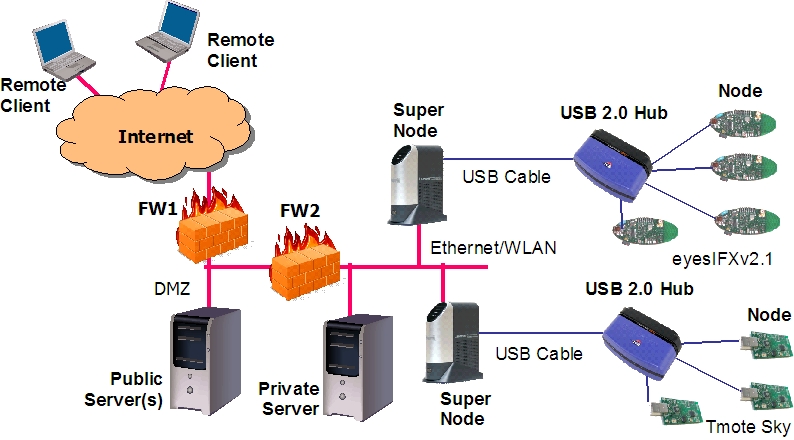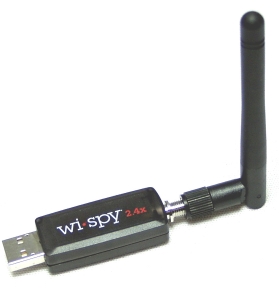TWIST (TUB)
Context
Due to their distributed nature, the design, implementation and evaluation of sensor network applications, middleware and communication protocols is a difficult task. The first design steps can often be made with the help of simulations, however, they frequently force the designer to make artificial assumptions about traffic, failure patterns and topologies. The later steps of implementation and evaluation of application performance as well as assessment of error resilience and other nonfunctional properties, require the use of real hardware, realistic environments and realistic experimental setups. Real experiments with distributed systems like sensor networks quickly become very cumbersome as soon as the number of nodes exceeds a few dozens. A testbed allows to create, modify and observe the target configuration (both hardware and software) in its whole complexity including nodes, communication protocols, middleware and application. TWIST is a scalable and flexible testbed architecture for experimenting with wireless sensor network applications in an indoor setting.
TWIST Testbed at TUBerlin
The TKN Wireless Indoor Sensor Network Testbed (TWIST) is a multiplatform, hierarchical testbed architecture developed at the Technische Universität Berlin [1]. The selfconfiguration capability, the use of hardware with standardized interfaces and opensource software makes the TWIST architecture scalable, affordable, and easily replicable. The TWIST instance at the TKN office building is one of the largest remotely accessible testbeds with 204 SUT (system under test) sockets, currently populated with 102 eyesIFX and 102 Tmote Sky nodes. The nodes are deployed in a 3D grid spanning 3 floors of an office building at the TUB campus, resulting in more than 1500 m2 of instrumented office space. In small rooms (~14 m²), two nodes of each platform are deployed, while the larger ones (~28 m²) have four nodes. This setup results in a fairly regular grid deployment pattern with intra node distance of 3m. Within the rooms the sensor nodes are attached to the ceiling.
 From left to right: Tmote Sky, eyesIFXv2, NLSU2 super node/USB hub
From left to right: Tmote Sky, eyesIFXv2, NLSU2 super node/USB hub
 Schematic overview of the main TWIST hardware components
Schematic overview of the main TWIST hardware components
The primary user interface is webbased and provides support for registration, configuration and monitoring of test jobs. The testbed resources can be shared among multiple users as long as each accesses different SUT platform. The webinterface is coupled to a background testbed server that uses a RPC architecture to distribute the testbed management tasks to the supernodes, where they are executed in parallel on the attached SUT nodes. TWIST provides automatic trace collection and centralized time stamping service, as well as raw access to the serial I/O of the SUT nodes. The webinterface is accessible via http://www.twist.tu-berlin.de. A sample hardware instantiation of the TWIST architecture is depicted below.
 Hardware instantiation of the TWIST architecture
Hardware instantiation of the TWIST architecture
 WiSpy USB dongle
WiSpy USB dongle
The WiSpy devices can be used as basic sensing devices in a CR setup.
TWIST Contribution to CREW
The TWIST instance at TUB will be made available as part of the CREW federated testbed.












